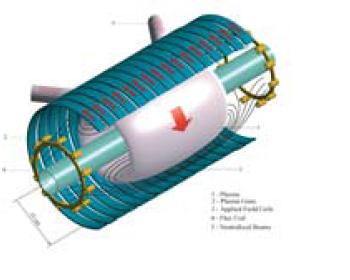Gallery of Small Fusion Startups
Bussard inertial electrostatic confinement fusion (EMC2 Fusion) involves an electrostatic plasma confinement to achieve fusion. The history and development of the concept is explained in a video reached via the link above. The Bussard IEC has been financed almost entirely by the US Navy. EMC2 is based near Santa Fe, New Mexico.
Lawrenceville Plasma Physics is based in New Jersey. The dense plasma focus approach uses a special pulsing "spark plug" to ionise a gas, and to form a plasmoid "pinch," with the emission of high energy photons, ions, and fusion neutrons.
Hyper V Technologies utilises a spherical array of mini railguns to accelerate plasma beams into a central target of deuterium or deuterium-tritium, to achieve fusion (hopefully).
TriAlpha is an Irvine, California venture, which has been fairly successful in the venture capital game. TriAlpha is a bit secretive with non-investors, but you can read their patent for yourselves. The concept seems to involve the highly sophisticated evolution from an earlier colliding beam fusion approach.
General Fusion is a small startup headquartered near Vancouver, BC. The compression of plasma to achieve fusion is accomplished by a coordinated spherical plasma compression, using pneumatics and advanced switching.
Helion Energy is located in Redmond, Washington. It is based on a principle of "colliding plasmas," and like all the rest of the small fusion approaches, it is a long shot.
Fusion reactors can be prolific neutron generators, and could be utilised for the transmutation of nuclear wastes into harmless compounds. They could also generate a number of differen highly energetic particles and high energy photons, and used for a number of purposes -- including as space propulsion. Another potential product of fusion reactions is heat. But what is most desired from fusion reactors is abundant, cheap, clean electrical power.
The energy from fusion is higher than the energy from fission, so that less fuel is required to generate equivalent energies. Fusion is generally safer, with less radioactive waste remaining to be disposed of.
Many billions of dollars have been spent by governments in a vain attempt to master the power of the stars on a more human scale. If one of the small startups manages to achieve with $millions what huge government budgets of $billions could not achieve, a revolution would have been ignited which would likely not stop with just cheap, clean, abundant energy.
Previously published at Al Fin Potpourri
Labels: fusion, picture galleries







2 Comments:
Measured by mass of fuel used, fusion generates more power than fission. However, measured by mole of fuel used, fission actually generates about 10 times more power than fusion. Also, the neutron flux resulting from D-T reaction is about 20 times that resulting from fission based on output power. Fusion, however, creates much less nuclear waste than fission. I think Thorium-based fission is better, overall, than D-T fusion. Of course the aneutronic fusion (p-B11) would be better than any fission.
If your powerplant is on a platform sensitive to mass -- aircraft or spacecraft -- the lower mass option is preferred.
A moonbase with no access to thorium might also prefer a He3 fuel cycle for fusion.
Earth-based stationary fuel plants are likely to use advanced fission (and fission / fusion hybrids) for a very long time, once rationality is restored to Terran governance.
If ORNL had been free of political and military influences, scientists and engineers there would have developed advanced and safe fission power a long time ago.
Small scale fusion, on the other hand, is still waiting for a few technological advances in materials, computing, and design -- and perhaps better physics theory -- before it can take off.
Post a Comment
Subscribe to Post Comments [Atom]
<< Home